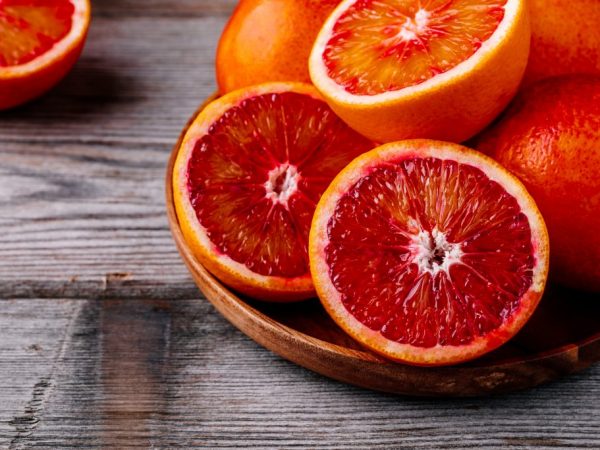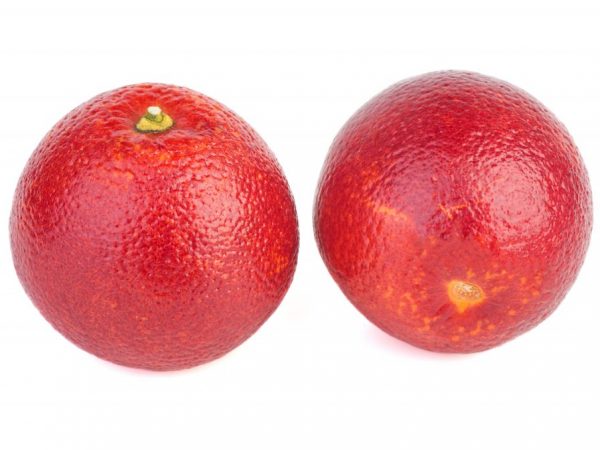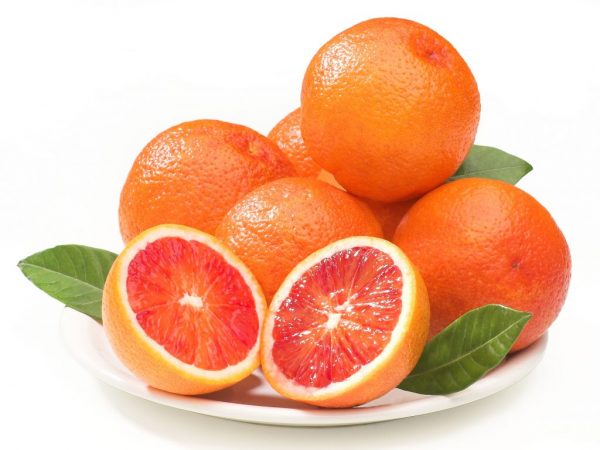What are the varieties of red orange
Red orange is a tasty and healthy exotic fruit. It has firmly won one of the first places among citrus fruits due to its qualities. His homeland is Sicily. Hence the second name of the fruit - the Sicilian orange.

Red orange varieties
Characteristic
Red orange has several other names: the king or bloody orange. The mutation from the common orange citrus first occurred on the island of Sicily in the 15th century. And since then it has been cultivated throughout Europe, the first fruit to appear in India.
The hybrid group, which includes citrus, is called Citrus × sinensis (translated as "Chinese citrus"). Oranges with red zest are made by crossing a pomelo and a tangerine.
Red orange has many varieties, most of them grow only in the Mediterranean strip. The name of the fruit (red oranges) comes from the color of their pulp, which is darker or lighter in different varieties due to the difference in seasonal temperatures in the homeland of the miracle fruit.
Description of the tree
Under natural conditions, the height of the red orange tree reaches 5.5-12 m. It blooms several times a season. This is one of the few plants that has both flowers and fruits from the previous harvest at the same time.
Blood orange trees belong to the rutic citrus family. Fruiting lasts for many years. The plant is tenacious.
Blood orange trees have the following traits:
- high;
- long-lived;
- constantly bearing fruit;
- unpretentious to soils;
- drought-resistant;
- with dense foliage;
- with a compact crown.
Round, gathered together, the compact crown looks attractive. The branches have thin thorns located directly towards the trunk.
The leaves are dark green, deep in color. They have an oval, slightly elongated shape. Leaf length - 6-7 cm, width - 3-4 cm.
The root system is large and can penetrate deeply into the soil. This quality allows blood oranges to survive dry periods.
Breeders have bred the dwarf trees of this fruit, and many growers purchase them to decorate their home interiors.
Description of fruits

The variety will surprise you with the color of the fruit
The tree blooms with large white flowers with a characteristic aroma. On a branch, flowers are collected in groups (5-6 pieces in one inflorescence). Some varieties are characterized by the presence of axillary shields for external protection.
The flowers produce fragrant fruits with the following characteristics:
- rounded ribbed shape;
- easily detachable peel;
- weight 100-300 g;
- few bones (seeds);
- brightly colored pulp.
The taste of orange fruit with red pulp is sweet, with a subtle sourness. After consumption, a pleasant raspberry aftertaste remains.
Anthocyanin gives the fruit a unique color. Different varieties have slightly different flesh and rind color. In the pulp, it ranges from bright red to red-burgundy, and in the rind, from orange-brown to dark brown.
Fruiting occurs from December to June. One adult tree grows up to 500-550 fruits.
Varieties of orange
There are several popular varieties of red oranges. Different varieties grow in horticultural farms in the USA, South Africa, Spain, Italy, China, and in subtropical countries. Basically, they all belong to the subgroup of the Spanish "king".
These varieties include:
- sanguinelli;
- tarocco (Tarocco);
- moro, morocco (Moro);
- Washington Nevil (Washingtoh Navel);
- Valencia (Valencia Late);
- Oval (Ovale).

Each variety has its own characteristics
Each variety has only its inherent characteristics:
- Sanguinello has medium-sized fruits, rind color of rust, flesh is bright red, juicy, pleasant and delicate in taste. The peel is easy to peel. The shape of the fruit is oval. Seeds are rare. This is a late-ripening variety. It is appreciated as a transitional grade, used in the preparation of fresh juices. The variety belongs to double kings. Has a subspecies Muscat sanguinello (fruits are larger and more elongated, nutmeg flavor of the pulp). An unripe fruit resembles a grapefruit.
- The round, slightly elongated shape of the fruit is typical for tarocco. His skin is orange, with light thin red stripes. The flesh tastes sweet with a slight sourness and a hint of berries. She has a garnet color. The fruit is easy to peel. Their weight is up to 200 g. This variety is characterized by a large amount of vitamin C. It is the most popular among the rest.
- The Moro variety has bright orange, oval citruses. This pigmented beetle ripens earlier than others. It is easy to determine full maturity by the red-yellow age spots. The peel is not thick, dense. The granularity is average. Few seeds. In the Moro variety, several varieties of mandarin and pamela are crossed. The pulp has a raspberry flavor. Moro contains a large amount of vitamins, minerals and beneficial acids. Fresh juices from red oranges are beneficial for both adults and children.
- Large fruits are of the Washington Neville variety. Their weight is up to 500 g. They are ellipsoidal or spherical. The peel is embossed and thick, up to 6-7 mm. The skin color is orange, in places red. The pulp has a cellular structure and a pleasant aroma. There are burgundy blotches in it. She, like the peel, is orange-red. There are few seeds.
- The Valencia variety has a rounded shape of citrus, up to 80 mm in size. The high sugar content determines the sweetness of the red oranges, which contain up to 9 seeds. The skin is thin, orange, with red veins. Valencia is especially common in horticultural businesses in California and Spain. The bright pulp produces an attractive and healthy juice that is popular.
- Ovale tastes like Valencia. The shape of the fruit is oval, the thickness is medium. This variety was developed in Italy. The Oval is characterized by a tight fit of the pulp lobules to each other. The rind is dense and rough, with tubercles, red-orange. There are no seeds in almost all citrus fruits. It is easy to grow such a variety by making a stock on an ordinary tree. Citrus Morocco is similar in quality to this variety. It is not difficult to choose the right one from a set of varieties.
The benefits and harms of red citrus
Red sweet citrus fruits are good for the human body. They have a set of vitamins and microelements: citric acid, sucrose, fiber, phytoncides, flavonoids and various carbohydrates.
Useful pectin, calcium and phosphorus are found in the pulp of fruits and enter the human body along with juices. This is especially important for the health of adolescents and schoolchildren. The essential oils found in the peel help in the treatment of skin conditions.
The calorie content of red orange is low, which makes it possible to use it for weight loss diets. Dietary fibers of the pulp increase in size, entering the stomach, after which a feeling of satiety appears. This is important for obese people. Santal, a juice from a store that looks like freshly squeezed, replaces a fruit if you want to pamper yourself with a tasty and healthy drink: it contains a minimum of calories.
The beneficial properties of the Sicilian red (bloody) orange help to strengthen the human immune system, improve metabolic processes. It is important to eat the product after the winter period, with spring vitamin deficiency, after serious illnesses or operations, to recover from food or chemical poisoning.
Red oranges are useful both fresh and dried, and in the form of jam or jam, which relieves the fever well in case of a cold. Application for bronchitis, pneumonia replaces antipyretic drugs.
For cosmetic purposes, saffron with a reddish orange extract is used. For hair, a mask made from such ingredients is indispensable. It makes hair silky and bouncy. A set of vitamins has a good effect on the hair structure.
Red oranges are not always beneficial. Contraindications include individual intolerance to the product. If you have a peptic ulcer or gastritis, you shouldn't eat sour Moroccan fruits. Small children and pregnant women should eat them after consulting a doctor.
Excessive consumption of these fruits causes harm to the gums, destruction of enamel and other dental problems. This is due to the high content of vitamin C.
Conclusion
Eating fruits, especially red citrus fruits, is desirable for everyone in order to feel normal at any time of the year. The main thing is to keep the correct proportions. The balance of useful microelements preserves health, prolongs youth and strengthens the immune system.


